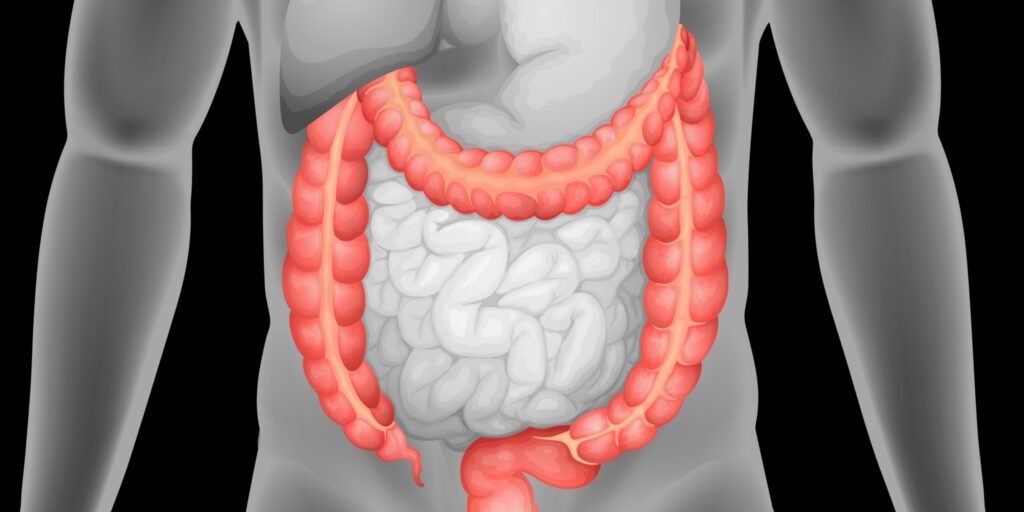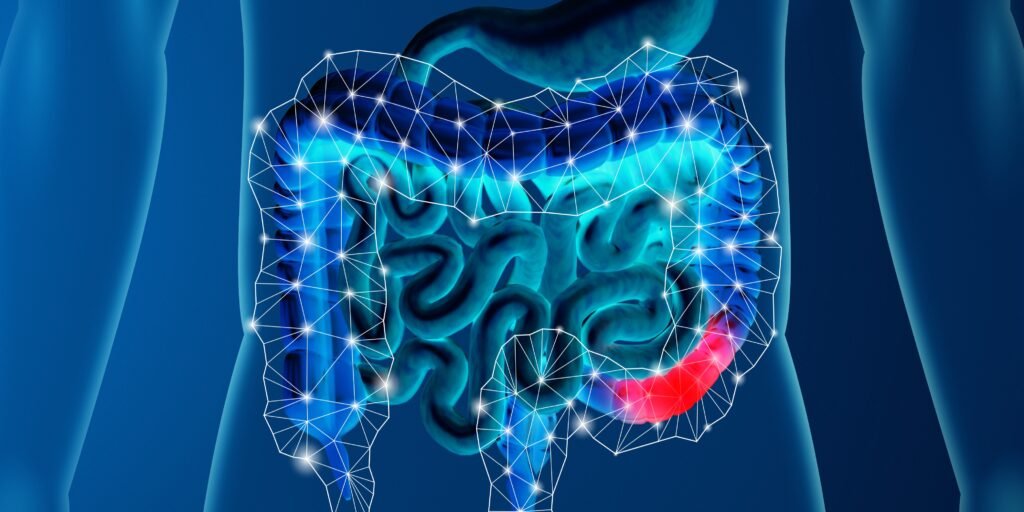Table of Contents
Welcome to the expansive realm of the large intestine, a vital segment of the digestive system that completes the intricate process of nutrient absorption and waste elimination. Also known as the colon, the large intestine is a remarkable conduit where the remnants of digestion undergo final refinement, water absorption, and the formation of feces. In this exploration, we delve into the anatomy, functions, and pivotal role of the large intestine—a winding pathway that transforms the remnants of our meals into the final product ready for excretion.
As we navigate through its sections, from the cecum to the rectum, we unravel the complexities that distinguish the large intestine’s role in maintaining digestive equilibrium. Join us on this journey into the world of the large intestine, where peristaltic waves guide the way, and the symbiotic relationship with gut microbiota influences both our digestion and overall well-being. Together, let’s unravel the mysteries of the large intestine, understanding its significance in the orchestration of our digestive symphony.
ANATOMY

The large intestine, also known as the colon, is a crucial part of the digestive system responsible for the absorption of water and electrolytes, as well as the formation and elimination of feces. Structurally, it is a muscular tube that extends from the cecum, where it connects to the small intestine, to the rectum and anus. The large intestine can be divided into several segments, each with distinct anatomical features and functions.
The cecum is the first part of the large intestine, forming a pouch-like structure in the lower right abdomen. Attached to the cecum is the appendix, a small, finger-like projection that doesn’t have a well-defined digestive function but may play a role in immune function.
The ascending colon ascends on the right side of the abdomen, followed by the transverse colon, which travels horizontally across the abdomen from right to left. The descending colon descends on the left side, leading to the sigmoid colon, which is an S-shaped segment that connects to the rectum. The rectum serves as a temporary storage site for feces before elimination.
The walls of the large intestine consist of four layers: the mucosa, submucosa, muscularis externa, and serosa. The mucosa is lined with simple columnar epithelium and contains intestinal glands that secrete mucus. The submucosa contains blood vessels and lymphatics, while the muscularis externa has longitudinal and circular smooth muscle layers responsible for peristalsis, the rhythmic contractions that propel feces through the colon.
Numerous pouches called haustra characterize the large intestine’s appearance, giving it a segmented appearance. Bands of longitudinal muscle, called taeniae coli, run along the length of the colon, creating the haustral formations.
The large intestine is richly supplied with blood vessels, including branches of the superior and inferior mesenteric arteries. Venous drainage is through the corresponding veins, ultimately leading to the portal vein and then to the liver.
The large intestine is home to a complex microbial community, known as the gut microbiota, which plays a crucial role in fermenting undigested carbohydrates, producing certain vitamins, and influencing immune function.
FUNCTION

The large intestine, also known as the colon, plays several essential functions in the digestive system and overall health. Here are the primary functions of the large intestine:
- Absorption of Water and Electrolytes: The major function of the large intestine is to absorb water and electrolytes from the remaining indigestible material, transforming the liquid chyme from the small intestine into a more solid form.
- Formation of Feces: As water is absorbed, the residual material undergoes dehydration, and the indigestible remnants, along with gut bacteria, are compacted to form feces.
- Storage of Fecal Material: The sigmoid colon acts as a storage reservoir for fecal material until it is ready to be expelled from the body. This storage allows for controlled and voluntary bowel movements.
- Fermentation of Undigested Carbohydrates: The large intestine is home to a diverse community of gut microbiota that assist in the fermentation of undigested carbohydrates, producing gases and short-chain fatty acids. These byproducts can have various effects on health.
- Synthesis of Vitamin K and B Vitamins: Gut bacteria in the large intestine contribute to the synthesis of certain vitamins, particularly vitamin K and various B vitamins. These synthesized vitamins play important roles in blood clotting and metabolic processes.
- Immune System Support: The large intestine houses a significant portion of the immune system. Gut-associated lymphoid tissue (GALT) and specialized immune cells help protect against harmful pathogens and contribute to overall immune function.
- Maintaining Gut Microbial Balance: The large intestine is crucial for maintaining a balance in the gut microbiota. A healthy balance of bacteria is essential for digestion, nutrient absorption, and immune system function.
- Control of Bowel Moments: The muscles of the large intestine, through peristaltic contractions, help move fecal material toward the rectum. The anal sphincters provide voluntary control over the release of feces during bowel movements.
- Absorption of Nutrients: While the majority of nutrient absorption occurs in the small intestine, the large intestine can absorb small amounts of water-soluble vitamins and electrolytes.
DISEASES

The large intestine, or colon, can be susceptible to various diseases and conditions that may affect its structure and function. Some common diseases associated with the large intestine include:
- Inflammatory Bowel Disease (IBD): Chronic inflammatory conditions that can affect different parts of the colon, leading to symptoms such as abdominal pain, diarrhoea, and rectal bleeding.
- Colorectal Cancer: Cancer that develops in the colon or rectum. Regular screening is crucial for early detection and treatment.
- Irritable Bowel Syndrome (IBS): A functional gastrointestinal disorder characterized by symptoms such as abdominal pain, bloating, and changes in bowel habits. IBS does not cause inflammation but can significantly impact quality of life.
- Diverticulitis: Inflammation or infection of small pouches (diverticula) that can form in the walls of the colon. Symptoms may include abdominal pain, fever, and changes in bowel habits.
- Colitis: Inflammation of the colon, which can have various causes, including infections, ischemia, or autoimmune reactions.
- Colonic Polyps: Abnormal growths on the inner lining of the colon. While most polyps are benign, some can develop into colorectal cancer over time.
- Ischemic Colitis: Reduced blood flow to the colon, often due to blood vessel blockages. This condition can lead to abdominal pain and changes in bowel habits.
- Infectious Colitis: Infections caused by bacteria, viruses, or parasites that lead to inflammation of the colon. Common symptoms include diarrhoea, abdominal pain, and fever.
- Celiac Disease: An autoimmune disorder where the ingestion of gluten leads to damage in the small intestine. While the primary impact is in the small intestine, it can also affect the large intestine.
- Microscopic Colitis: Inflammation of the colon that can only be seen under a microscope. It includes collagenous colitis and lymphocytic colitis, both of which cause chronic diarrhoea.
It’s important to note that some of these conditions can have overlapping symptoms, and accurate diagnosis often requires medical evaluation, including imaging studies, endoscopy, and laboratory tests. Timely medical intervention is crucial for the effective management of these conditions and to improve the overall quality of life for affected individuals.
HEALTHY LARGE INTESTINE

Maintaining a healthy large intestine involves adopting lifestyle habits that support digestive health and reduce the risk of diseases affecting the colon. Here are some general tips to promote a healthy large intestine:
- Fiber-Rich Diet: Include a variety of high-fiber foods in your diet, such as whole grains, fruits, vegetables, legumes, and nuts. Fiber supports regular bowel movements and helps prevent constipation.
- Adequate Hydration: Drink plenty of water throughout the day to keep the digestive system hydrated. Water helps soften stool and supports efficient bowel movements.
- Limit Processed Foods: Reduce the consumption of processed and refined foods, which may lack essential nutrients and fiber. Opt for whole, unprocessed foods for better digestive health.
- Probiotic-Rich Foods: Incorporate probiotic-rich foods, such as yoghurt, kefir, sauerkraut, and kimchi, into your diet. Probiotics support a healthy balance of gut bacteria.
- Regular Exercise: Engage in regular physical activity to promote overall health, including digestive health. Exercise can stimulate bowel movements and reduce the risk of constipation.
- Maintain a Healthy Weight: Strive to maintain a healthy weight through a balanced diet and regular exercise. Obesity is a risk factor for certain digestive conditions, including colorectal cancer.
- Limit Red and Processed Meat: Reduce the intake of red and processed meats, as high consumption has been associated with an increased risk of colorectal cancer.
- Regular Screenings: Adhere to recommended colorectal cancer screening guidelines. Regular screenings, such as colonoscopies, can help detect precancerous lesions or early-stage cancer for timely intervention.
- Limit Alcohol and Tobacco Use: Limit alcohol consumption and avoid tobacco use. Both alcohol and smoking are linked to an increased risk of colorectal cancer and other digestive conditions.
- Manage Stress: Practice stress-management techniques such as meditation, deep breathing, or yoga. Chronic stress can negatively impact digestive health.
- Adequate Sleep: Ensure you get enough quality sleep each night. Sleep plays a crucial role in overall health, including the functioning of the digestive system.
- Hygienic Practices: Practice good hygiene, especially handwashing, to prevent the spread of infections that could affect the digestive system.
In conclusion, the large intestine, a vital segment of the digestive system, orchestrates the final act in the intricate ballet of nutrient absorption and waste elimination. As we navigate its winding pathways—from the cecum to the rectum—we uncover the pivotal role it plays in water absorption, feces formation, and the maintenance of digestive equilibrium. Nurturing a healthy large intestine involves embracing lifestyle habits that support overall well-being—fiber-rich nutrition, regular exercise, hydration, and probiotic inclusion.
Let us appreciate the resilience of this often overlooked organ, acknowledging its significance in the symphony of digestion. May our journey through the large intestine serve as a reminder to prioritize digestive health, fostering a harmonious relationship with this remarkable conduit that contributes to our overall vitality.

